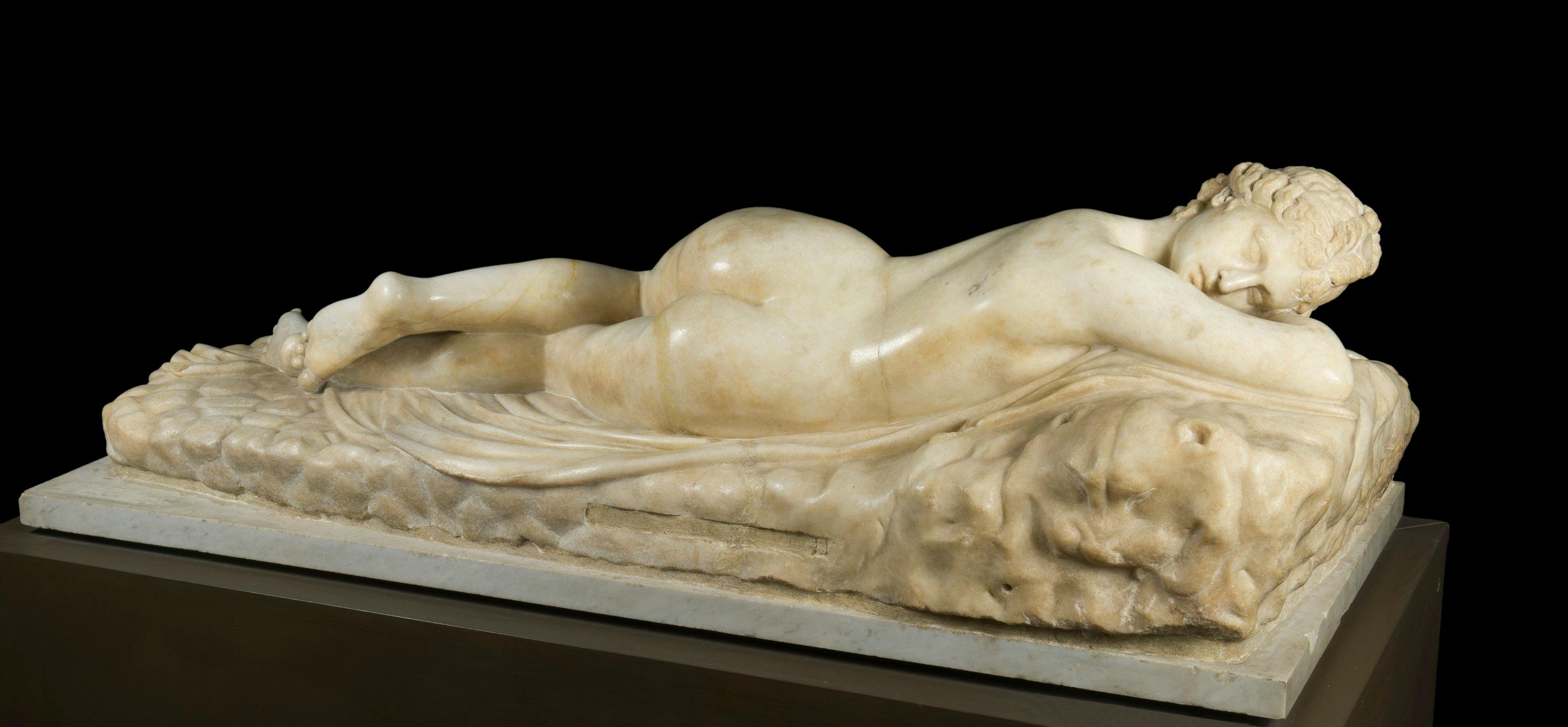Hermaphroditus
Hermaphroditus
The physical and emotional centre of the room is the statue of Hermaphroditus, an antique marble that entered the Medici family's patrimony at the time of Cardinal Leopold (1617-1675), who in 1669 purchased it for his brother Ferdinand II (1610-1670) from the Ludovisi collection in Rome, where it was preserved in the villa near Porta Pinciana (Anguissola 2010). Thanks to its exceptional nature, the marble immediately earned a place in the family gallery on the top floor of the Vasari complex. A curiosity: together with it came the carved wooden plinth created especially for the work in the 17th century, as well as the blue damask cover that used to accompany it.
The importance of this myth for the lives of the ancients is confirmed by the archaeological evidence through which the image is known and by written sources (Bernardini Mazzolla 1979). Between 3 and 8 A.D., the Latin poet Ovid (43 BC-18 AD), on the eve of the exile that would take him far from Rome at the behest of Augustus (63 BC-14 a.D.), in Book IV of the Metamorphoses, verses 285-388, tells the story of the divine child born from Hermes and Aphrodite who, at the age of fifteen, escaped from the Cretan cavern of Mount Ida, where he had been lovingly cared for, to take refuge in Caria (present-day Turkey). There, while bathing in a spring, the young man was surprised by a naiad (nymph) named Salmacis, who, in an attempt to seduce him and within a complex game of role reversals, clings to him praying the gods to never separate their bodies again. The gods satisfied her request and Hermaphroditus, who was transformed against his will, asked and obtained from his divine parents that the spring in which this transformation took place could have the power of debilitating the virility of men bathing in it.
Carved from a block of fine marble from the Greek island of Paros, the young Hermaphroditus is depicted while sleeping, naked, lying on his stomach, on a feral skin thrown on a rocky ground, like a makeshift bed. His body, with its soft and shapely female form, is depicted with a slight rotation of the pelvis that reveals his dual nature as man and woman. The figure draws a sort of chiasmus: the head turned to the right and resting on the palm of the hand, the left leg bent at the knee and tied to the right one. The face in front of us is that of an adolescent entering his youth, with softened features, a small, slightly open mouth and sharp chin. He is framed by an elaborate hairstyle with long, soft hair held by a band and divided on the forehead into two ringlets blocked by a jewel and tied in a knot at the nape, from which emerge small, dishevelled curls, stylistically similar to the hairstyles of children.
The golden, almost alabaster-like shade of the marble seems to mimic the natural colour of the complexion, as well as the careful smoothness of the surface. The almost total loss of skin at the heels might have been caused by heavy rubbing.
The moment depicted by the artist is not present in the narration of the myth, and perhaps the fact that he’s sleeping can be explained due to the presence of the animal leather that links the figure of Hermaphroditus to the thiasus of Dionysus, thus allowing to think that the child is portrayed in a state of inebriation. Another connection with the world of Dionysus is represented by a small sculptural group dated to the Roman period, which is also exhibited in this museum, where Hermaphroditus appears together with Pan; or by a more famous and widely replicated group, the so-called Dresden Symplegma, where Hermaphroditus is depicted during a sort of erotic game in which he escapes from a Satyr who is trying to hold him back.
The creation of this statuary model, which is part of a broader trend of sleeping figures, had great fortune in the Roman world of the Hadrianic-Antonine age. We have knowledge of no less than seven replicas, the most famous of which is preserved at the Louvre Museum and was restored by Bernini. The prototype, which was perhaps created in Italy, must, however, be dating back to few centuries before, to the late Hellenistic period, that is, to a time that renewed the use figurative language in the artistic field, which is expressed by the choice of an iconographic type that combines not only an interest in the unusual and exceptional, but also a study of the psychology of the character, who appears exposed in all his vulnerability in a moment of languid abandonment.
The Uffizi Hermaphroditus is the only piece whose original context is unknown. The other replicas for which it was possible to retrace the origin are connected to residential quarters intended for otium, to thermal buildings, gymnasiums and even to theatres, where the reference to the sphere of water and the cult and ostentation of the body is stronger than elsewhere (Anguissola 2010).
Publio Ovidio Nasone, Metamorfosi, a cura di P. Bernardini Marzolla, Torino 1979; G. Mansuelli, Galleria degli Uffizi. Le sculture, vol. I, Roma 1958;A.Anguissola, Nec utrumque e utrumque videtur: osservazioni sull’Ermafrodito addormentato degli Uffizi, in Studi e restauri. I marmi antichi della Galleria degli Uffizi, v. III, a cura di Antonella Romualdi, Firenze 2010, pp. 21-75; A.Romualdi, Introduzione, in Studi e restauri. I marmi antichi della Galleria degli Uffizi, v. III, a cura di Antonella Romualdi, Firenze 2010, pp. 11-17; A.Natali, La virtù dei mecenati. La nuova Sala dell’Ermafrodito, in La Virtù del Principe. L’Allegoria di Jacopo Ligozzi, Gli Uffizi. Studi e ricerche 30, a cura di Francesca de Luca e Marta Onali, Firenze 2015, pp. 11-18.
